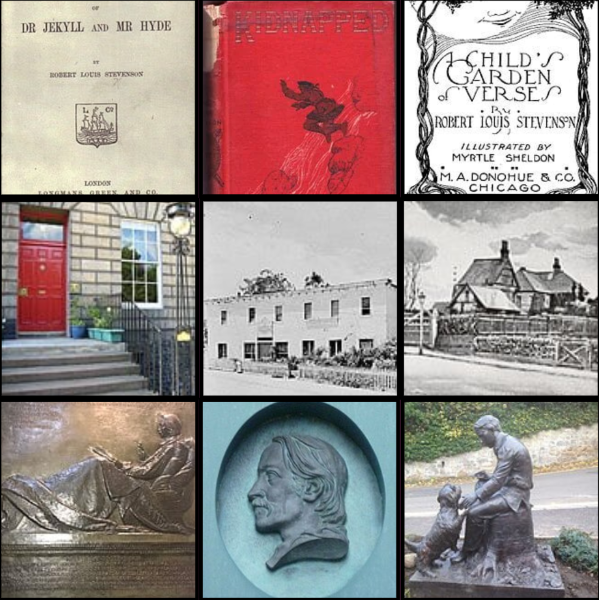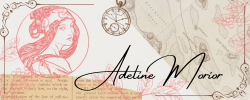Collage:
 Imgur Link - Larger Version [1800 x 1800 px]
Write-Up:
Imgur Link - Larger Version [1800 x 1800 px]
Write-Up:
In the centre of the collage, we can see a photograph of
Robert Louis Stevenson captured by Henry Walter Barnett in 1893. To the left of this photograph, we can see Stevenson posing for a photograph in Samoa in 1890. Just below these photographs, there is a photograph of Stevenson with his family and the Samoan household. Right above the two portrait photographs, there is a photograph of Stevenson with his family in 1893. He is with his wife Fanny Stevenson, his stepdaughter Isobel, and his mother Margaret Balfour. Below this family photograph, we can see the cover illustration of his book, “The Black Arrow”. To the left of the family photograph, there is an image of the cover illustration for his book “The Strange Case Of Dr. Jekyll And Mr. Hyde”. To the left of that book cover, there is an image of the cover illustration for his book “The Master of Ballantrae”. Right below it, we can see the cover for one of his most famous books, “Treasure Island”. And lastly, we can see the cover for another book by Stevenson, titled “The Bottle Imp”.
Robert Louis Stevenson was born on 13 November 1850, in Edinburgh, Scotland. He was christened Robert Lewis Balfour Stevenson, however, when he turned 18 in 1873, he changed the spelling of "Lewis" to "Louis", and dropped "Balfour" from his name. Despite suffering from severe bronchial problems throughout his life, Stevenson managed to travel extensively and write a lot. His father, Lewis Balfour, and daughter also had weak chests and needed to stay in warmer climates for their health. The family moved to a damp and cold house at 1 Inverleith Terrace in 1851, which led Stevenson to develop coughing and fevers that persisted until he was 11 years old. After moving to a sunnier place, 17 Heriot Row, when Stevenson was 6 years old, he still struggled with illness, particularly in winter. Even as an adult, he faced health issues that left him very thin. Although people initially suspected tuberculosis, recent assessments suggest that Stevenson may have had bronchiectasis or sarcoidosis.
Stevenson was a prolific letter writer, and his letters (edited by Sidney Colvin in 1899) provide a captivating and vivid portrayal of Stevenson's life. However, Colvin omitted many of the most intriguing letters, combined others, and left out several significant details about Stevenson's emotional life until the complete text of all the letters was available. Fanny Sitwell received Stevenson's letters from Colvin, which are now at the National Library of Scotland. She was not allowed to open them until 1949. The engrossing letters to Charles Baxter, a close friend, were deposited in the Yale University Library.
Some of his most famous works include
“Treasure Island”,
“The Strange Case of Dr Jekyll and Mr Hyde”,
“Kidnapped”,
“The Black Arrow” and
“A Child's Garden of Verses”.
In June 1888, Stevenson, along with his family, chartered a schooner yacht named Casco for a healthy and enjoyable journey. However, this turned out to be a lifelong expedition for them as they explored the South Seas. They started with the Marquesas Islands, Fakarava Atoll, Tahiti, and spent almost 6 months in Honolulu. In 1889, they continued their journey by visiting the Gilbert Islands and Samoa, where they stayed for 6 weeks.
While visiting the South Sea Islands, Stevenson made a significant effort to understand the local community and its inhabitants. As a result of his observations, his writings about the South Seas, including "In the South Seas" (1896) and "A Footnote to History" (1892), are very insightful and colourful. He wrote excellent journalism, which was enriched by his perception of the surroundings and environment, as seen in his portrayal of the first landfall at Nuku Hiva in the Marquesas.
He returned to Samoa from a trip to Sydney in October 1890, and he settled down with his family at Vailima, his home in Samoa. There, he enjoyed a highly respected and paternal position among the locals. The Samoan climate was ideal for him, and he lived a productive and active life.
Stevenson passed away on 3 December 1894, not from tuberculosis, but due to a cerebral haemorrhage.










